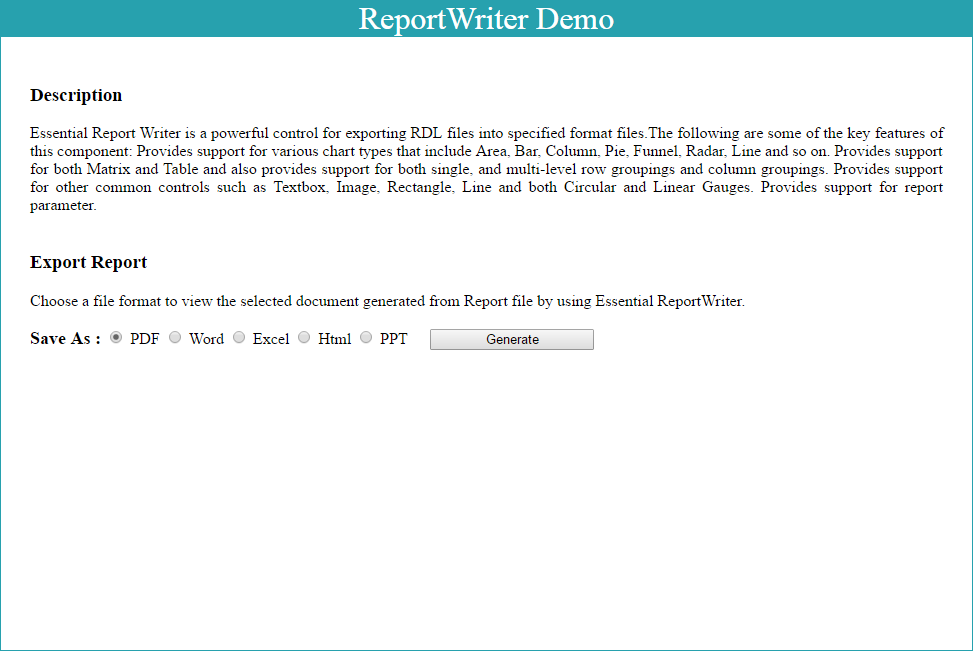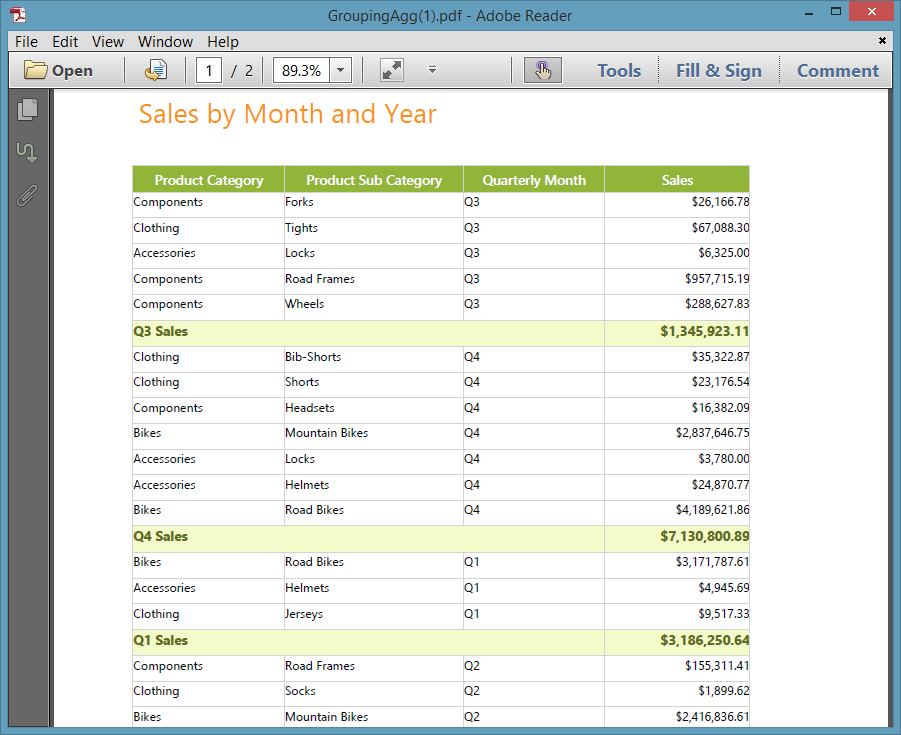Getting Started with ASP.NET MVC Application
12 Sep 201822 minutes to read
This section describes how to export the Report Server report as PDF, Word, Excel, PPT and HTML formats in ASP.NET MVC application using ReportWriter.
Project Creation
This section illustrates how to add ReportWriter to the ASP.NET MVC application. It includes the following steps.
-
Create a new ASP.NET MVC project by selecting the WEB category from the listed project template in Microsoft Visual Studio IDE.

-
The following screenshot displays how to select empty application template with razor view engine.

Create CSHTML Page
To create a new CSHTML view page in the application follow the below steps.
-
Right click on the ReportWriter folder from Views followed by Add and then click View.

-
Specify the name and then click on OK.

Add References
-
In the Solution Explorer, Right-click the References folder and then click Add Reference.

-
Add the following references
- Syncfusion.Chart.Wpf
- Syncfusion.Compression.Base
- Syncfusion.DocIO.Base
- Syncfusion.EJ.ReportViewer
- Syncfusion.Gauge.Wpf
- Syncfusion.Linq.Base
- Syncfusion.Pdf.Base
- Syncfusion.SfMaps.Wpf
- Syncfusion.Shared.Wpf
- Syncfusion.XlsIO.Base
NOTE
Refer the above assemblies from the installed location, C:\Program Files (x86)\Syncfusion\Essential Studio\ASP.NET MVC\32.1.19\Assemblies
Registering Assemblies within the Web.config file
In your application’s root web.config file, add the below assembly information within the <assemblies> tag.
<system.web>
<compilation debug="true" targetFramework="4.5">
<assemblies>
<add assembly="Syncfusion.Chart.WPF, Version=14.1400.0.42, Culture=neutral, PublicKeyToken=3d67ed1f87d44c89"/>
<add assembly="Syncfusion.Compression.Base, Version=14.1400.0.42, Culture=neutral, PublicKeyToken=3d67ed1f87d44c89"/>
<add assembly="Syncfusion.DocIO.Base, Version=14.1400.0.42, Culture=neutral, PublicKeyToken=3d67ed1f87d44c89"/>
<add assembly="Syncfusion.EJ.ReportViewer, Version=14.1400.0.42, Culture=neutral, PublicKeyToken=3d67ed1f87d44c89"/>
<add assembly="Syncfusion.Gauge.WPF, Version=14.1400.0.42, Culture=neutral, PublicKeyToken=3d67ed1f87d44c89"/>
<add assembly="Syncfusion.Linq.Base, Version=14.1400.0.42, Culture=neutral, PublicKeyToken=3d67ed1f87d44c89"/>
<add assembly="Syncfusion.Pdf.Base, Version=14.1400.0.42, Culture=neutral, PublicKeyToken=3d67ed1f87d44c89"/>
<add assembly="Syncfusion.SfMaps.WPF, Version=14.1400.0.42, Culture=neutral, PublicKeyToken=3d67ed1f87d44c89"/>
<add assembly="Syncfusion.Shared.WPF, Version=14.1400.0.42, Culture=neutral, PublicKeyToken=3d67ed1f87d44c89"/>
<add assembly="Syncfusion.XlsIO.Base, Version=14.1400.0.42, Culture=neutral, PublicKeyToken=3d67ed1f87d44c89"/>
</assemblies>
</compilation>
</system.web>Registering namespaces within Web.config
Now you need to register the below mentioned two namespaces in the web.config file present within the Views folder as well as the Root directory of your application.
- Syncfusion.EJ.ReportViewer
<namespaces>
<add namespace="System.Web.Mvc"/>
<add namespace="System.Web.Mvc.Ajax"/>
<add namespace="System.Web.Mvc.Html"/>
<add namespace="System.Web.Routing"/>
<add namespace="System.Web.WebPages"/>
<add namespace="Syncfusion.EJ.ReportViewer"/>
</namespaces>ReportWriter Initialization
-
Initialize ReportWriter by using the controller in the Application. To create a controller in the Application, please follow the below steps.

-
Specify the name to the controller and then click on OK.

-
Set the following properties to ReportWriter.
-
ReportPath - Set the local file system or Report Server path of report.
-
ReportProcessingMode - Set ProcessingMode as Remote for RDL and Report Server report also Local for RDLC report.
-
WriterFormat - Set WriterFormat as PDF, Excel, Word and HTML.
-
-
Add the following code to the ReportWriter in the controller class.
public ActionResult Index(string writerFormat) { try { string fileName = null; WriterFormat format; HttpContext httpContext = System.Web.HttpContext.Current; ReportWriter reportWriter = new ReportWriter(); reportWriter.ReportPath = Server.MapPath("~/App_Data/GroupingAgg.rdl"); reportWriter.ReportProcessingMode = ProcessingMode.Remote; if (writerFormat == "PDF") { fileName = "GroupingAgg.pdf"; format = WriterFormat.PDF; } else if (writerFormat == "Word") { fileName = "GroupingAgg.doc"; format = WriterFormat.Word; } else if (writerFormat == "Html") { fileName = "GroupingAgg.Html"; format = WriterFormat.HTML; } else if (writerFormat == "PPT") { fileName = "GroupingAgg.ppt"; format = WriterFormat.PPT; } else { fileName = "GroupingAgg.xls"; format = WriterFormat.Excel; } reportWriter.Save(fileName, format, httpContext.Response); } catch { } return View(); } -
Add the following code example in the <body> tag of the CSHTML page to view ReportWriter export options.
<body> <div class="container"> <div class="header"> <span style="color: white; font-size: 2em">ReportWriter Demo</span> </div> <div class="content_section"> @{Html.BeginForm("Index", "ReportWriter", FormMethod.Post); { <div id="description_Pane" style="text-align: justify;"> <h3>Description</h3> <span> Essential ReportWriter is a powerful control for exporting RDL files into specified format files.The following are some of the key features of this component: Provides support for various chart types that include Area, Bar, Column, Pie, Funnel, Radar, Line and so on. Provides support for both Matrix and Table and also provides support for both single, and multi-level row groupings and column groupings. Provides support for other common controls such as Textbox, Image, Rectangle, Line and both Circular and Linear Gauges. Provides support for report parameter. </span> </div> <div id="export_Pane" style="margin-top: 4%;"> <h3>Export Report</h3> <span> Choose a file format to view the selected document generated from Report file by using Essential ReportWriter. </span> <div id="selection_Pane" style="margin-top: 2%;"> <span style="font-size:large;"> <strong>Save As : </strong> </span> <input type="radio" name="writerFormat" value="PDF" checked="checked" /> <label for="btnPDf">PDF </label> <input type="radio" name="writerFormat" value="Word" /> <label for="btnWord">Word </label> <input type="radio" name="writerFormat" value="xls" /> <label for="btnxls">Excel </label> <input type="radio" name="writerFormat" value="Html" /> <label for="btnHtml">Html </label> <input type="radio" name="writerFormat" value="PPT" /> <label for="btnHtml">PPT </label> <input type="submit" name="button" value="Generate" style="width: 18%; margin-left: 2%;"/> </div> </div> Html.EndForm(); } } </div> </div> </body> -
Run the application. The following output displays ReportWriter export options, Select the export option and click on Generate button.

-
The following output displays exported report in the PDF format.

Generate RDL Reports
The ReportWriter has options to save the RDL reports. The following code example helps you to generate the RDL report using ReportWriter.
Specify the ReportPath, ReportProcessingMode and WriterFormat properties for ReportWriter to generate report.
string reportPath = @"..\ReportTemplate\GroupingAgg.rdl";
ReportWriter reportWriter = new ReportWriter(reportPath);
reportWriter.ReportProcessingMode = ProcessingMode.Remote;
reportWriter.Save("GroupingAgg.xls", WriterFormat.Excel);Generate RDLC Reports
The ReportWriter has support to view and save the RDLC reports. The following code helps you to bind data to ReportWriter.
-
Assign
ReportPath,ProcessingModeandExportFormatto ReportWriter.string reportPath = @"..ReportTemplate\RDLC\ProductCatalog.rdlc"; ReportWriter reportWriter = new ReportWriter(reportPath, dataSources); reportWriter.ReportProcessingMode = ProcessingMode.Local; reportWriter.Save("ProductCatalog.doc", WriterFormat.WORD); -
Add Datasource to the RDLC report.
ReportDataSourceCollection dataSources = new ReportDataSourceCollection(); dataSources.Add(new ReportDataSource { Name = "ProductCatalog", Value = ProductCatalogSource.GetData() }); -
Assign values for the datasource which is given in the RDLC.
#region ProductCatalog Details public class ProductCatalogSource { public string ProdSubCat { get; set; } public string ProdModel { get; set; } public string ProdCat { get; set; } public string Description { get; set; } public string ProdName { get; set; } public string ProductNumber { get; set; } public string Color { get; set; } public string Size { get; set; } public double? Weight { get; set; } public double? StandardCost { get; set; } public string Style { get; set; } public string Class { get; set; } public double? ListPrice { get; set; } public static IList GetData() { List<ProductCatalogSource> datas = new List<ProductCatalogSource>(); ProductCatalogSource data = null; data = new ProductCatalogSource() { ProdSubCat = "Road Frames", ProdModel = "HL Road Frame", ProdCat = "Components", Description = "Our lightest and best quality aluminum frame made from the newest alloy; it is welded and heat-treated for strength. Our innovative design results in maximum comfort and performance.", ProdName = "HL Road Frame - Black, 58", ProductNumber = "FR-R92B-58", Color = "Black", Size = "58", Weight = 2.24, StandardCost = 1059.3100, Style = "U ", Class = "H ", ListPrice = 1431.5000 }; datas.Add(data); data = new ProductCatalogSource() { ProdSubCat = "Road Frames", ProdModel = "HL Road Frame", ProdCat = "Components", Description = "Our lightest and best quality aluminum frame made from the newest alloy; it is welded and heat-treated for strength. Our innovative design results in maximum comfort and performance.", ProdName = "HL Road Frame - Red, 58", ProductNumber = "FR-R92R-58", Color = "Red", Size = "58", Weight = 2.24, StandardCost = 1059.3100, Style = "U ", Class = "H ", ListPrice = 1431.5000 }; datas.Add(data); data = new ProductCatalogSource() { ProdSubCat = "Helmets", ProdModel = "Sport-100", ProdCat = "Accessories", Description = "Universal fit, well-vented, lightweight , snap-on visor.", ProdName = "Sport-100 Helmet, Red", ProductNumber = "HL-U509-R", Color = "Red", Size = "", Weight = null, StandardCost = 13.0863, Style = "", Class = "", ListPrice = 34.9900 }; datas.Add(data); return datas; } } #endregion
Generate SSRS Reports
The ReportWriter has options to export the SSRS reports. The following code example helps you to generate the SSRS report using ReportWriter.
Specify the ReportPath, ReportServerUrl, ReportServerCredential, ReportProcessingMode and WriterFormat properties for ReportWriter to generate report.
HttpContext httpContext = System.Web.HttpContext.Current;
ReportWriter reportWriter = new ReportWriter();
reportWriter.ReportPath = "45db67a0-3fd6-4684-b03c-aa640a521c97";
reportWriter.ReportServerUrl = "http://reportserver.syncfusion.com:80/";
reportWriter.ReportingServer = new ReportingServerExt();
reportWriter.ReportServerCredential = new System.Net.NetworkCredential("guest", "demo");
reportWriter.ReportProcessingMode = ProcessingMode.Remote;
reportWriter.Save("GroupingAgg.doc", WriterFormat.Word, httpContext.Response);